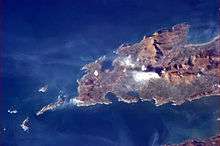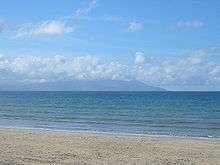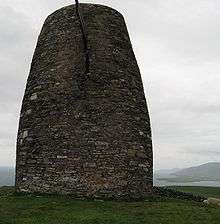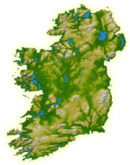Dingle Peninsula
The Dingle Peninsula (Irish: Corca Dhuibhne; anglicised as Corkaguiny, the name of the corresponding barony) is the northernmost of the major peninsulas in County Kerry. It ends beyond the town of Dingle at Dunmore Head, the westernmost point of Ireland and arguably Europe.[1]
| Corca Dhuibhne | |
|---|---|
 Location of the Dingle Peninsula | |
| Geography | |
| Location | Ireland |
| Adjacent bodies of water | |
| Area | 583 km2 (225 sq mi) |
| Highest elevation | 952 m (3,123 ft) |
| Highest point | Mount Brandon |
| Administration | |
| County | Kerry |

Name
The Dingle Peninsula is named after the town of Dingle. The peninsula is also commonly called Corca Dhuibhne (Corcu Duibne) even when those referring to it are speaking in English. Corca Dhuibhne,[2] which means "seed or tribe of Duibhne"[3] (a Goddess, a Gaelic clann name), takes its name from the túath (people, nation) of Corco Dhuibhne who occupied the peninsula in the Middle Ages and who also held a number of territories in the south and east of County Kerry.
Geography
The peninsula exists because of the band of sandstone rock that forms the Slieve Mish mountain range at the neck of the peninsula, in the east, and the Brandon Group of mountains, and the Mountains of the Central Dingle Peninsula further to the west. Ireland's highest mountain outside MacGillycuddy's Reeks, Mount Brandon at 951 m, forms part of a high ridge with views over the peninsula and North Kerry.
Conor Pass, which runs from Dingle on the south-western end of the peninsula towards Brandon Bay and Castlegregory in the north-east, is the highest mountain pass in Ireland, a narrow, twisting road; it weaves its way around the sharp cliff faces and past the high corrie lakes.
The Blasket Islands lie off the west coast. They are known for the literary and linguistic heritage of the former inhabitants. However, these remote islands have been uninhabited since the 1950s following an evacuation.
Culture and language
The western end of the peninsula is a Gaeltacht (Irish-speaking area) that has produced a number of nationally notable authors and poets; Ó Siochfhradha and Peig Sayers among others. This is the westernmost part of Ireland, and the village of Dún Chaoin is often jokingly referred to as "the next parish to America."
Archaeology
The peninsula is the location of numerous prehistoric and early medieval remains including:
- Glanfahan, site of ancient dry-stone huts (clocháns)
- Caherdorgan North, with medieval stone buildings
- Ballywiheen, containing an ancient stone fort and monastic settlement
- Kilmalkedar, monastic settlement with Ogham stone
- Ferriter's Cove, at the western tip of the peninsula; and
- Gallarus Oratory in the very west of the peninsula near the village of Baile an Fheirtéaraigh in Ard na Caithne.
Músaem Chorca Dhuibhne, situated in the village of Baile an Fheirtéaraigh (Ballyferriter) has exhibitions detailing the archaeology and history of the peninsula. Some of the exhibitions include Ogham stones, artefacts from the excavations at the nearby monastic site of Riasc (Reask) and objects on loan from the National Museum of Ireland.[4]
Places of interest

The peninsula is known for the MV Ranga, a Spanish cargo vessel that wrecked on the coast in 1982.[5]
Gallaunmore is a standing stone and National Monument.
Rahinnane Castle is a 15th-century castle built on a medieval ringfort.
In film
David Lean's 1970 film Ryan's Daughter takes place at a village on the Dingle Peninsula in the immediate aftermath of the 1916 Easter Rising, and was partly shot on location near Dún Chaoin, Coumeenole Beach, Slea Head and Inch Strand.[6] Far and Away, a 1992 film directed by Ron Howard, was partly filmed on the peninsula.[7]
The film Leap Year is partly set in the Dingle Peninsula, but none of the filming took place in the area.[8]
Gallery
 The Dingle Peninsula as viewed from Banna Strand.
The Dingle Peninsula as viewed from Banna Strand. Dingle Peninsula coastline.
Dingle Peninsula coastline. Minard Castle, Lispole, County Kerry.
Minard Castle, Lispole, County Kerry. Eask Tower, with the tip of the Ring of Kerry in the background.
Eask Tower, with the tip of the Ring of Kerry in the background. The livestock of Dingle Peninsula.
The livestock of Dingle Peninsula. Beaches near Dunmore Head.
Beaches near Dunmore Head. Garfinny Bridge, medieval bridge and National Monument
Garfinny Bridge, medieval bridge and National Monument
See also
References
- MacCulloch, JR (1837). Statistical Account of the British Empire (volume 1). London: Charles Knight & Co. p. 345. Retrieved 13 May 2014.
- Suzanne Barrett's Ireland for Visitors, April 2009
- "Ireland's Dingle Peninsula Tourism, April 2009". Archived from the original on 21 March 2007. Retrieved 26 April 2009.
- "Músaem Chorca Dhuibhne: Exhibitions". Músaem Chorca Dhuibhne. Archived from the original on 9 October 2011. Retrieved 7 April 2011.
- Hertz, Kayla (25 April 2017). "Fascinating shipwrecks across the Wild Atlantic Way". IrishCentral. Retrieved 31 August 2017.
- "Ryan's Daughter (1970): Locations". IMDb. Retrieved 31 May 2011.
- "Far and Away (1992): Locations". IMDb. Retrieved 31 May 2011.
- "Leap Year (2010/1): Locations". IMDb. Retrieved 31 May 2011.
External links

- 2007 Comprehensive Gaeltacht Linguistic study
Destination Ireland: Dingle. Ireland's Homes Interiors & Living. No. 225. March 2014.

